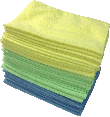Have you ever really come across anything more annoying or difficult to clean than burnt rice on a pot or pan? Removing burnt rice is something that everyone will have to face a few times in their life, and if you already have, then you know how frustrating this task can really be. Well, instead of simply throwing your hands up and screaming in frustration, why not try one of these helpful and effective methods for removing burnt rice? Soon, you won't have to deal with that nasty gunk any more, and you will have your pots and pans nice and clean again.
- Start by soaking. As always, it is a good idea to begin with the traditional methods before moving onto one of the newer fangled ones. As such, perhaps one of the most traditional methods for removing burnt rice is to allow the pot to soak for a while. Simply fill your pot or pan halfway with some hot soapy water, and then allow it to cool. Once the water has reached room temperature, the burnt rice should have loosened enough that you can remove it very easily with some light scraping. For particularly stubborn rice burns you may need to repeat the process a few times to ensure that you remove everything. After you have removed all of the rice, be sure to wash the pot or pan as you normally would.
- Baking soda can be a help. Another method you can use to remove burnt rice is to add about three table spoons of baking soda to about two cups of water. Pour this mixture into the pot, and then place the pot onto the stove and heat to a gentle boil. Allow the water to boil for about three minutes, and then remove. Scrape the bottom of the pan, and then wash as you normally would.
- Boil some soapy water. In the event that you don't have any baking soda to put into the water, you can always use a little bit of soap. However, instead of only boiling the water for three minutes, you will need to do it for five minutes before removing it from the heat. Scrape the bottom as outlined in the other methods and then wash as normal and you should notice that your pot is now rice free.
- Simmer some vinegar. While it is always best to use a cleaning agent like baking soda or dish soap, you really don't need to. Another great method is to use some simple white vinegar. Simply add one table spoon of white vinegar to every cup of water that you put into the pot, and then turn the heat up. Boil the vinegar and water mixture, and then let it simmer for ten minutes. Once again scrape the bottom of the pot, and then wash as normal
Author Bio
Lee Wyatt
Contributor of numerous Tips.Net articles, Lee Wyatt is quickly becoming a regular "Jack of all trades." He is currently an independent contractor specializing in writing and editing. Contact him today for all of your writing and editing needs! Click here to contact. Learn more about Lee...
Choosing the Proper Grass Seed Mix
Choosing the proper grass seed mix may seem a little stressful to the beginning gardener, but it really doesn't need to ...
Discover More
Creating a Dramatic Garden
Gardens are more than just a source of fruit, vegetables, and herbs that we can use in the kitchen. Gardens are also a ...
Discover More
Using Electrical Testers
Electrical testers are a great tool to have when you do any type of electrical work. Unfortunately, if you don't know how ...
Discover More
Cleaning Silverstone Cookware
One of the more popular types of nonstick cookware that is currently available goes by the name of Silverstone. If you ...
Discover More
Cleaning Fine China
What is keeping you from using that beautiful fine china that is neatly stacked and safely stowed away in the back of ...
Discover More
Removing Burnt Chili
Have you ever noticed how difficult it can be to get rid of burnt chili? For some reason removing burnt chili is a fairly ...
Discover More

Comments